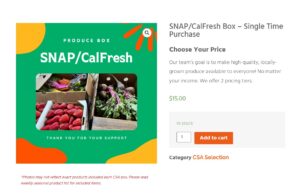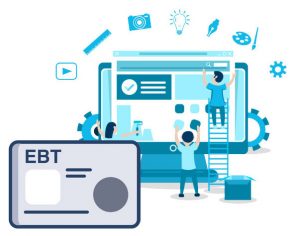If you’ve ever wondered, “How do stores make money from food stamps?” or “How much do grocery stores make from food stamps?” you’re not alone. A store must apply with the United States Department of Agriculture’s (USDA) Food and Nutrition Services (FNS) program to begin accepting food stamps at their business. Any business that meets eligibility requirements, such as most grocery stores, some gas stations, and others, can apply. Retailers who want to offer this service to their SNAP program participants must apply for an FNS number by providing certain information about their store, including the types of food they sell and how much of the store’s gross revenue comes from food sales.
How do grocery stores make money from food stamps? Accepting food stamps opens a retailer to a much larger shopping demographic, so accepting food stamps can boost your overall revenue.
To apply for your FNS number for food stamps, go to the USDA’s FNS website and follow the application instructions. You’ll need to have various documents and information about your store when you apply, such as your name, your business’s name, contact information, and annual food sales revenue figures.
FNS acceptance and EBT merchant accounts
Once you’ve been accepted and you have your FNS number, you might have to find a new merchant account service provider if your current provider doesn’t process EBT payments. You may even need to upgrade your point-of-sale (POS) system. But worry not — Bankcard can help with both.
Suppose you accept EBT card payments each time a customer uses their Supplemental Nutrition Assistance Program (SNAP) benefits (previously known as the food stamp program) in your store. In that case, the sale amount is immediately subtracted from their SNAP EBT benefits balance and added to your FNS account, which then deposits the money into your business’s bank account within two business days. Accepting EBT cards allows Americans the option of shopping in your store and is a discreet way they can access their benefits.
What are food stamps, and how do they work?
SNAP is a federally funded benefit program that helps low-income individuals and families meet eligibility requirements to supplement their budgets for food purchases while also offering encouragement to purchase healthier foods.
In the past, food stamps were provided in the form of paper stamps or coupons that looked like “white paper money.” Paying with these paper stamps had a three-fold issue:
- Stores had to collect them, send them in, and wait to be reimbursed, which often took a while, meaning cash revenue was held up.
- Customers were announcing to the store, the clerk, and every shopper in the same checkout that they were paying with food stamps—which added to the shame many people already felt about being on state assistance.
- Because these benefits were somewhat like cash, it was easy for people to sell the stamps for cash.
Today’s electronic benefits transfer programs provide recipients with a plastic card that works just like a traditional debit or credit card. Recipients receive their allotted disbursements to their cards each month and can use the card at SNAP-participating supermarkets or farmers’ markets and even at online grocers such as Amazon Pantry and Walmart.
Why don’t all stores that sell food accept food stamps?
When you consider how much money grocery stores make from food stamps, you might think all stores accept SNAP. But not all stores accept EBT or SNAP payments, and there are a couple of reasons why. The first reason is pretty simple:
The store owner doesn’t want to.
And that, of course, is a personal decision. If it’s a small, family-run business, the owners may not want to participate in the program. The criteria to qualify may be out of their control or unattainable, or the owners may feel that program rules are too strict. The owners may not want to risk falling out of compliance. It is, after all, not a given that food stores must take food stamps.
On the other hand, after realizing how grocery stores make money from food stamps, the store may have applied to accept EBT and food stamps. But the USDA FNS program subsequently denied their application. Stores must apply to accept EBT payments, and there are several criteria the store must meet to qualify.
For instance, stores must sell specific types of food and/or meet specific revenue guidelines. If a store doesn’t sell the types of foods listed on the USDA FNS website as staple foods, doesn’t offer the required amount of staple foods, or less than 50% of the store’s revenue comes from food sales, the USDA FNS program will deny the store’s application. If the store wants to accept EBT, they’re qualified according to the FNS rules, and the FNS accepts the store’s application, the store must follow strict rules and guidelines on EBT payment acceptance, such as what can be purchased using SNAP funds.
Why should I apply to accept food stamps at my grocery store?
While the application for an FNS requires a lot of information, it’s a relatively streamlined process. Accepting EBT cards lets you offer your products to more of your community. Plus, EBT card processing costs much less than traditional credit or debit card processing. EBT card processing with Bankcard comes with free EBT equipment, a flat monthly fee regardless of processing volume, and round-the-clock support — all without a contract. With EBT merchant services, you can appeal to SNAP benefit recipients as well as TANF beneficiaries.
If you have a web presence, you can now even offer online purchase support for EBT card holders.
Bottom line, if your store is eligible to accept EBT cards, whether for SNAP, TANF, or both, there really isn’t any reason you shouldn’t. As mentioned, EBT card processing fees are insignificant. And most of today’s cash registers and payment processing software programs are already set up to accept these payments and properly account for the division between food and retail products. While there is an application process, and it can take up to three weeks for a response, once you’ve been approved, you’ll notice an increase in revenue because you’ve opened your business to an additional segment of your community. It helps your community and your store — a literal win/win for everyone.

Does accepting SNAP really improve revenue?
It’s in a store’s best interests — and its community’s best interests — to accept EBT SNAP. Stores around the nation accept EBT and SNAP payments, and it’s not limited to just grocery stores. Gas stations, convenience stores, farmers’ markets, and even online food sellers can qualify to accept EBT payments.
So, why doesn’t every store that’s eligible to accept SNAP actually accept this payment method? How do grocery stores make money from food stamps? Does it really improve revenue?
Well, it’s not mandated by the USDA FNS program that every eligible business must accept food stamps. Businesses aren’t mandated to accept any form of payment. Store owners are free to decide what types of payments they’ll accept.
But yes, accepting SNAP or EBT can indeed boost your revenue. CNBC found that retailers saw a 19% growth in revenue from SNAP shoppers during the pandemic. According to IRI, 12% of all food and drink sold online and in-person in 2020 were SNAP sales, accounting for $74 billion in the industry.
How much do grocery stores make from food stamps?
Businesses and consumers alike can see multiple benefits of EBT card acceptance. SNAP recipients can shop anywhere that accepts EBT cards. They can increase the amount of food in their home each month and can even purchase better quality foods than they could without these benefits.
How much money do grocery stores make from food stamps? As of the Fed’s last report, SNAP retailers earned over $60 billion in 2018, and with increases in allowed monthly benefits for SNAP recipients and the addition of P-EBT disbursements to families with school-age children, this amount is expected to climb, especially as more stores opt to offer EBT card acceptance.
You can experience the benefits of EBT payment processing at your store, too. You open your business to a brand new customer base which boosts your revenue and cash flow. You may have accepted food stamps in the past and discontinued your participation due to the time it took to count paper stamps, mail them in, and wait for reimbursement. Since EBT cards get processed just like a debit cards, your checkout lanes run much more smoothly, and you no longer have to wait so long for reimbursement. If you don’t yet accept EBT cards, it’s worth looking into now, even if you wonder, “how do stores make money from food stamps?”
Individuals receiving Temporary Assistance for Needy Families (TANF) get cash benefits deposited on their EBT card, just like SNAP benefits.
Recipients receiving both TANF and SNAP will see that these two balances are separate, as you may notice on customer receipts—there’s a Food Benefit Balance, and a Cash Benefit Balance reported at the bottom of all receipts for purchases using an EBT card. Having an EBT card with both TANF and SNAP benefits is like having a bank account with a savings and a checking account attached—both accounts belong to the cardholder, but the balances are separate.
What can recipients buy with TANF benefits?
TANF benefits can be used to buy household items, such as toilet paper, cleaning supplies, and other items. TANF benefits can even buy food if the recipient so chooses. SNAP benefits, on the other hand, can only be used for food purchases and not for non-food items. Neither TANF benefits nor SNAP benefits can be used to purchase items on the restricted list, such as alcohol or tobacco products—doing so can get the customer and your business in trouble. The Supplemental Nutrition Assistance Program only allows purchases of eligible items, and grocery retailers need to avoid these and other mistakes as a SNAP participating retailers.
While it’s technically illegal, this doesn’t stop some participants from using an automated teller machine (ATM) to withdraw cash funds from the TANF side of their EBT card to make these forbidden purchases.
Reporting EBT Fraud
EBT fraud is committed by both EBT recipients (such as when they sell or attempt to sell benefits) and by stores (such as if they allow restricted item purchases by ringing the items up under different product codes to skirt the rules).
In the event you suspect improper recipient use of TANF or SNAP benefits or you have evidence of a store not following FNS rules and regulations, you can call the USDA’s Office of Inspector General at (800) 424-9121.
You can also write to the USDA Inspector General at:
PO Box 23399
Washington, DC 20026-3399
Visit the USDA FNS website to submit an EBT fraud report online.
EBT Merchant Services with Bankcard
How do stores make money from food stamps? How much money do grocery stores make from food stamps? If you want to know and help your community at the same time, choose Bankcard. When you partner with Bankcard for your EBT merchant services account, you’ll enjoy transparent pricing and receive the equipment you need to process EBT card payments—plus, you get the added benefit of knowing you’re helping out your community by providing this much-needed service. Reach out to Bankcard to see how we can help get you set up quickly.







